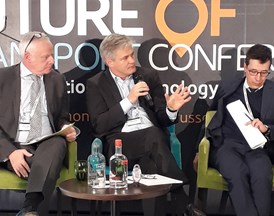05 Mar 2020
Arriva blog: Modal shift is central to delivering Europe’s future mobility

Manfred Rudhart, Arriva CEO
Following my address to delegates at Forum Europe's 'Future of Transport' conference in March 2020, I shared some thoughts on the central role that modal shift to public transport must play in the minds of policymakers if we’re to succeed in reaching net zero by 2050.
When we think about the future of transport, what is it we want it to deliver?
We need the future of transport to be green and sustainable to help tackle one of the biggest issues society faces: climate change. And we need to provide effective and attractive transport systems to deliver healthy and prosperous communities.
My message to delegates at the Future of Transport Conference in Brussels was that central to delivering future transport therefore lies modal shift from private to public transport.
The environmental and societal case for modal shift is overwhelming.
The transport sector is the fastest growing source of emissions and 83% of all passenger journeys in Europe are currently made by private car. Yet, with one full double decker bus able to take up to 75 cars off the road, public transport is simply a greener and more environmentally friendly option – and it’s available today; we don’t need to wait for the future!
Some might argue that the environmental question will be solved by the introduction of large numbers of electric cars on Europe’s roads. That will certainly help, but air quality and emissions are not the only issues which need to be tackled.
80% of Europe’s population is expected to live in an urban area by 2050. With growing demand for mobility, our towns and cities will become even more gridlocked with privately owned cars, electric or not.
By shifting towards public transport, not only can emissions and air quality levels improve but congestion can reduce, too.
And there’s another added benefit of modal shift: healthier communities.
As the World Health Organisation notes, shifting to public transport is associated with a wide range of health benefits, including more physical activity and less obesity by encouraging more active travel.
Cars currently take up a third of dedicated infrastructure. These cars, however, are on average parked for 23 hours a day. The space they take up could be used for more sustainable modes such as walking, cycling or public transport.
So, how can we make modal shift happen?
Let’s start by putting public transport at the heart of sustainable mobility strategies. Through concerted leadership and working in partnership, across all modes, we can turn the dial on modal shift and create future transport networks which are truly sustainable and help deliver Europe’s climate targets.
Contact information
Phil Curry
Senior Communications Manager
Arriva Group press office
+44 (0)7825 342 976
curryp@arriva.co.uk

